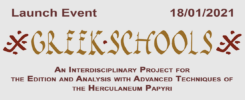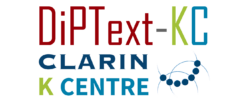EUPORIA 2021 was a Webinar Cycle on Annotation of Literary and Documentary Texts through Domain-Specific Languages aiming at sharing ideas and experiences on Domain-Specific Languages applied to research in the Humanities and was an occasion to meet creators of formal grammars and users of formal languages for encoding critical apparatus or linguistic, stylistic and multimedial annotations.
EUPORIA 2021 was organized by the Institute for Computational Linguistics “A. Zampolli” of the National Research Council of Italy (CNR-ILC), the Laboratory of Anthropology of the Ancient World of the University of Pisa (UniPI-LAMA), the Venice Centre for Digital and Public Humanities of the Department of Humanities of the Ca’ Foscari University of Venice (UNIVE-DSU VeDPH) and CLARIN-IT as a contribution to CLARIN.
Webinars were held as virtual events between 30 November 2020 and 15 March 2021 and were aimed at the publication of a monograph.
The abstracts of the contributions presented at EUPORIA 2021 and the video recordings of the related interventions follow below.
Monday 30/11/2020
Monday 07/12/2020
Monday 11/01/2021
Religious landscapes and ritual dynamics in ancient Greek tragedy: annotation with DSLs in Anthropology of Greek religion
by Gloria Mugelli and Giulia Re
Euporia RAGT and Euporia LanGT are two related projects which adopt DSLs in a digital annotation for hermeneutics of ancient Greek tragic texts, in the field of Anthropology of Greek Religion. The annotation work is based on the same corpus and conceived to grant interoperability, although using two DSLs tailored on different research questions. Some case studies from Sophocles’ Oedipus Coloneus will show the formal and conceptual specificities of each DSL. The first one adopts a bottom-up approach, while the second one is based on semi-structured annotations expressed in triples. We will present and discuss the operating principles of an ontology modeling the key concepts of Greek religion and ritual, which can be used for querying the database of the annotated textual passages.
Monday 18/01/2021
Annotating the metre of ancient Greek and Latin
by David Chamberlain
I am engaged in an open access (CC-BY) project to document the metrical patterns of all of Classical Greek and Latin. TEI xml allows for tagging metre in a few different ways, but none of them have proven to be adequate to the needs of this project, above all because of a conflict between TEI conventions for tagging speakers in drama and the need to identify metrical patterns based on the unit of the line, and because they do not well allow for syllabic representation of phenomena such as elision and crasis, especially in Greek. I have chosen not only to eschew TEI, but xml itself, since my project relies on representation in html both for annotation itself, and then for publishing of results.
Monday 25/01/2021
Learning Greek and Latin with digital annotation: the Euporia4Education project
by Paola Tosoni
She illustrates the theoretical bases of EuporiaEdu, which is the methodology developed to involve high school students in the collaborative and cooperative annotation of ancient Greek (and Latin) texts.
Euporia4Education project in Siracusa: analysis and translation of the Parodos of Aeschylus’ Persae
by Marilena Crucitti and Ludovica Bosco
They describe the experience of teachers and students by adopting EuporiaEdu at Syracuse.
The class without walls: the tutor’s experience
by Filippo Lepori
He illustrates his experience as a tutor that supported teachers and students that adopted EuporiaEdu in Pisa.
Euporia4Education and Moodle
by Paola Lacasella
She discusses how to create a didactic unit by exploiting digital resources created by the students.
Monday 01/02/2021
EuporiaRhetorica and DiLAR (Digital Lexicon of Ancient Rhetoric)
by Amedeo Alessandro Raschieri
The Digital Lexicon of Ancient Rhetoric (DiLAR) Project aims to build a digital lexicon of Latin terms of rhetoric and, in its first phase of development, analyses and studies the Rhetorica ad Herennium and the rhetorical works of Cicero. The project intends to fill a gap not only in Digital Humanities but also in traditional lexicographical studies. The main feature of the project is to start from the direct annotation of the rhetorical works to complete the lexicographic entries; the final user can then choose the direction of consultation and move intertextually between texts and rhetorical index. Euporia enables those who annotate the text to focus on rhetorical issues, but at the same time to keep track of other content – as stylistic and linguistic information – that can then be retrieved and used later. Using Euporia is like having at your disposal the wide margins of a medieval manuscript where one can write cross-references, annotations and comments to create a paratext that not only allows moving more easily along the original text but also to offer new and more complete information to subsequent readers.
Monday 08/02/2021
Producing born-digital critical edition of Syriac texts: The Challenge of Syriac Florilegia
by Emiliano Fiori
The ERC project “FLOS-Florilegia Syriaca”, based at Ca’ Foscari University of Venice, is publishing born-digital editions of anthologies written in Syriac, a variety of Aramaic. These anthologies, of the 8th-9th centuries, contain extracts from writings of Greek Christian writers of late antiquity in Syriac translation. FLOS will publish born-digital editions of these anthologies through collaboration with the ILC, which is transforming the docx files containing our texts into files characterized by a light markdown system. The digital workflow is further implemented through collaboration with the platform Musisque Deoque, originally conceived for Latin poetry and also based at Ca’ Foscari.
ARISTOTELEUM, Versioning the Wiener Aristoteles
by Silvia Fazzo
Editing Aristotle has been an open challenge over the last two centuries, which is still open in our times, once one realizes that standard methods are unapt to the present needs. For instance, no complete recognition has ever been made of the most antique manuscript: the so-called Wiener Aristoteles, which contains the most ancient available text of all of the physical and metaphysical treatises by Aristotle (about 20.000 Bekker lines). Versioning the Wiener seems to be an immense task, whose even partial accomplishment would significantly affect Aristotelian studies. Hence our proposal: developing a working environment with a fully integrated equipment, expressly conceived for senior and advanced scholars.
Monday 15/02/2021
Smart technologies and digital intelligence
by Ritamaria Bucciarelli et al.
The present work focuses on samples from Iliad and Odyssey, and carries out a formal understanding of the Homeric text with a paraphrase generator implementation, which requires: 1) a morpho-syntactic rhetorical analysis, in order to detect the traits of formularity in quantum theories (Planat, 2014, 2016); 2) a formal analysis of the most frequent linguistic technique in Homer’s formulary style; 3) the use of Nooj contest (Silberztein, 2015, 2016), for the formalisation of sentences and implementation with automatic production of paraphrases on the search engine and the Web Semantics. Some details of the methodologies will be explained.
Monday 22/02/2021
The digital edition of Giorgio Bassani’s notes
by Angela Siciliano and Giovanni Alberto Amato
Note is a particular type of textuality: it’s a text that is strictly connected to another text (a printed text or a manuscript), which is underlined, glossed and explained. Making the critical edition of notes philologists need to analyse how texts are linked together: an important issue, because trying to represent notes and the related text philologists face some difficulties. Besides, notes aren’t only textual annotation, but also underscores, brackets and other marks that a critical edition could partially represent, producing a loss of information. The annotations written by Giorgio Bassani in the margins of his books are an interesting case study. Starting from difficulties that the philologist faces in editing Bassani’s notes, the contribution will explain why we have decided to create a digital edition of notes marked by the author in a very important book, “La scuola dell’uomo” by Guido Calogero (Firenze, Sansoni, 1939). We will compare traditional representation of notes and the digital one, analysing methods, models and tools.
Monday 01/03/2021
XML & JSON: interchangeability and case studies
by Daria Spampinato, Pietro Sichera and Salvatore Cristofaro
The Semantic Web is an extension of the classic web that allows to overcome some fundamental problems such as the deconstruction of information and its ambiguity, the lack of aggregation within specific contexts, the absence of adequate systems for the transfer of information, the difficulty in searching, maintaining and preserving reliable data. The semantic web therefore requires easy methods for the use and exchange of information both by humans and computers. To pursue this objective, XML and JSON file formats are used. The webinar aims to show differences and similarities between the two formats, to understand their potential and use.
Monday 08/03/2021
Annotating The name of the rose: a hermeneutic approach from DSL to TEI
by Christian D’Agata
The philological, linguistic, and thematic annotation of the variants of Umberto Eco’s The name of the rose poses many questions from a hermeneutic perspective. The use of DSLs allows a free and respectful approach to the hermeneutic circle, where great importance is given to the taking awareness of the prejudice dictated by the methods and the context of interpretation. We need a trade-off between the freedom offered by a research-driven approach and the benefits of interoperability. For this reason, the second phase of our work addresses multiple revision cycles and the definition of a common and exportable tag vocabulary. In the third and final phase, we finally develop XSLT stylesheets to arrive at an XML-TEI output to share.
The Piraeus Lion’s project work and future outlook
by Paola Peratello
On the basis of the literature gathered on the Piraeus Lion at the Venetian Arsenal, a website has been created as a virtual space collecting various types of contents regarding the Piraeus Lion: videos, photos, a 3D point cloud, a secondary-literature timeline, C.C. Rafn’s article on the runes of the statue (1855) in Danish, and the relative English translation. Both scholars and generic users indeed benefit from easy access to the website and its contents. With particular reference to the 3D point cloud, photos of each side of the statue of the Lion have been collected and processed by means of Agisoft Metashape: the final result is an image-based polygonal mesh. A future outlook will be discussed: more specifically, the annotation of metadata to a 3D point cloud, from an epigraphical and philological perspective.
Monday 15/03/2021
How to leverage DomainDriven Design to foster Digital Scholarly Editing and DSL
by Angelo Mario Del Grosso
The field of digital scholarly editing is deemed to be particularly challenging from a software engineering point of view. Indeed, after decades of research activities, computational philology still lacks effective tools and efficient procedures organized in common interfaces, decoupled application services and domain-specific commodities. As a matter of fact, there is neither convergence on how to model software applications to meet philological requirements nor traditional philologists fully satisfied with the current digital solutions. By adopting the Domain Driven Design approach, we start our modeling activities by defining the problem space of our domain which, in turn, is broken into small components (called sub-domains) to progressively refine the ongoing digital models. In this way, together with the experts, we are able to identify the main capabilities of the field we want to model and strive to design coherent domain-specific solutions for such capabilities (bounded contexts).
DomainSpecific Languages as the key for Cartesian Documents
by Francesco Sarnari and Riccardo Del Gratta
We try to sketch a formal definition of digital textual documents. Digital documents are defined as objects consisting of three components: content, i. e. text, format, i.e. how the content is arranged in the document, and para-textual layers, i.e. notes, glosses, etc. The separability of these components is a crucial aspect to determine similarities and dependencies among documents.



